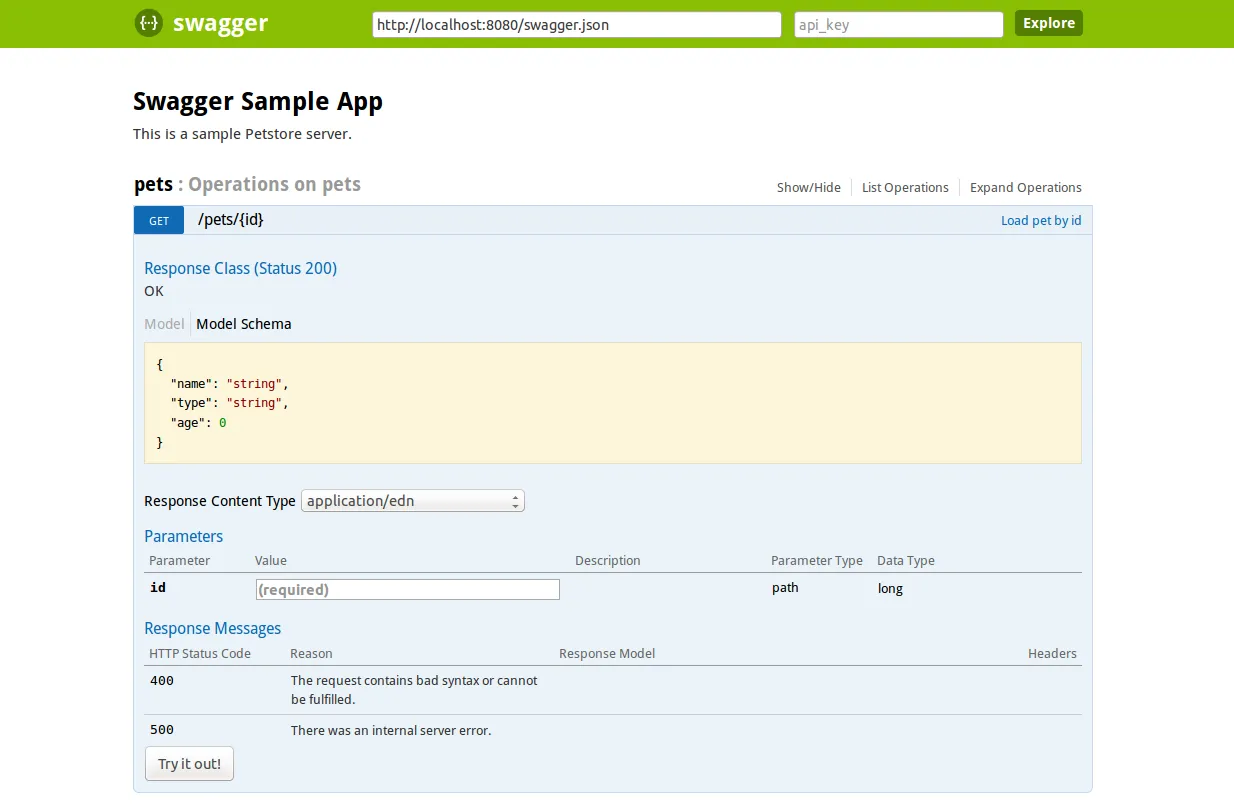Swagger and Schema
A couple of years ago I watched a EuroClojure talk by Tommi Reiman about the excellent work Metosin had done on implementing the Swagger spec for Compojure, which at the time was the routing library du jour. I and many others have had a go at building a metadata-driven API over the years with varying levels of success, but none were as sophisticated as this. For the first time, it was starting to feel like a complete solution - the Swagger spec and its comprehensive UI, Schema and its excellent declaration, validation and coercion characteristics, and Compojure with its syntax.
However, Compojure and Ring never felt like a natural fit for this task. After using bidi for bi-directional routing I never wanted to go back, and the tower of middleware in Ring only grew with the sort of middleware needed by an API. Just knowing that, under the hood, Compojure macros were being “peeled” made me feel a bit uneasy about the whole thing.
Pedestal reborn
After the split of Pedestal and Pedestal App the whole project started making a lot more sense. Fellow Juxter Frankie Sardo saw the opportunity to use Pedestal’s data-driven, composable approach to annotate and inspect the API structure in a much simpler manner, and thanks to ring-swagger was able to easily implement the Swagger spec. The result was pedestal-swagger which has been used with great success in several projects.
Introducing pedestal-api
Frankie has since been working on a Pedestal-inspired routing library for Clojurescript called tripod which led him to change pedestal-swagger into a framework-agnostic route-swagger, usable by both. This meant my personal preference for a more “batteries included” library required a new project, so here it is: pedestal-api.
The aim of pedestal-api is to provide a collection of tools for building an API using Pedestal, based on route-swagger and providing interceptors which implement the parts of HTTP that apply best to APIs. This includes validation, coercion, deserialization, content negotiation and more with the intention of allowing you to pick and choose what you want without feeling like you are using a framework.
What it looks like
We will start with defining a schema of a pet and a Swagger endpoint to
retrieve it, given its id. The id will be supplied as a
path-parameter.
(ns pedestal-api-example.service
(:require [io.pedestal.interceptor :refer [interceptor]]
[pedestal-api
[core :as api]
[helpers :as helpers]
[schema.core :as s]))
(s/defschema Pet
{:name s/Str
:type s/Str
:age s/Int})
(def load-pet-by-id
(api/annotate
{:summary "Load pet by id"
:parameters {:path-params {:id s/Int}}
:responses {200 {:body Pet}}}
(interceptor
{:name ::load-pet-by-id
:enter (fn [ctx]
(let [id (get-in ctx [:request :path-params :id])
pet (load-from-db id)]
(assoc ctx :response
{:status 200
:body pet})))})))load-pet-by-id is an interceptor that declares a path-parameter
called id, and will return a Pet in response. The id parameter
will be placed in path-params inside the request, and coerced to an
integer by the provided pedestal-api interceptors. Similarly, the pet
that is returned will be validated against the Pet schema and
serialised for the client.
We then declare the server routes and interceptors, annotated with Swagger documentation and including pedestal-api’s interceptors.
(api/defroutes routes
{:info {:title "Swagger Sample App"
:description "This is a sample Petstore server."
:version "2.0"}
:tags [{:name "pets"
:description "Everything about your Pets"
:externalDocs {:description "Find out more"
:url "http://swagger.io"}}
{:name "pets"
:description "Operations on pets"}]}
[[["/" ^:interceptors [api/error-responses
(api/negotiate-response)
(api/body-params)
api/common-body
(api/coerce-request)
(api/validate-response)]
["/pets/:id" ^:interceptors [(api/doc {:tags ["pets"]})]
{:get load-pet-by-id}]
["/swagger.json" {:get api/swagger-json}]
["/*resource" {:get api/swagger-ui}]]]])
That’s it - this is enough to generate the following Swagger UI:

There are also some helpers that let you define interceptors more
succinctly; we can rewrite the one above as follows using
helpers/handler:
(def load-pet-by-id
(helpers/handler ::load-pet-by-id
{:summary "Load pet by id"
:parameters {:path-params {:id s/Int}}
:responses {200 {:body Pet}}}
(fn [request]
(let [id (get-in request [:path-params :id])
pet (load-from-db id)]
{:status 200
:body pet}))))Feedback welcome
The project on GitHub contains a complete CRUD example which you can try on Heroku and it’s used in real life as well. If you are using pedestal-swagger it provides a good upgrade path, and if you’re starting a new project it’s worth considering. As always feedback, suggestions and pull requests are very welcome.







